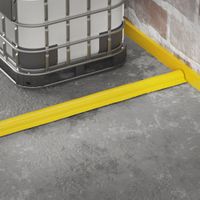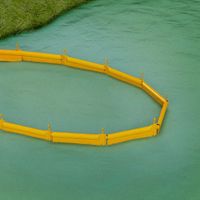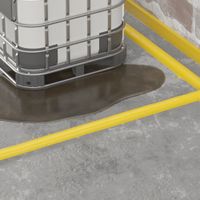Call +(254) 703 030 000 / 751 483 999 / 721 704 777
- Home
- Safety
- Sorbents Spill Control Spill Containment
- Spill Containment Berms Dikes Pools
.....Read More
Frequently Asked Questions
What are spill containment berms used for?
Spill containment berms are used as a preventive and protective measure to manage and contain spills of hazardous materials, chemicals, oils, fuels, and other potentially harmful substances. They serve several critical functions:
1. **Environmental Protection**: Berms prevent contaminants from seeping into the ground, thereby protecting soil and groundwater from pollution. This is crucial in maintaining ecological balance and preventing long-term environmental damage.
2. **Regulatory Compliance**: Many industries are required by law to have spill containment measures in place to comply with environmental regulations. Berms help companies meet these legal requirements, avoiding fines and legal issues.
3. **Safety**: By containing spills, berms reduce the risk of accidents and injuries in the workplace. They prevent hazardous materials from spreading, which could otherwise lead to slips, falls, or exposure to toxic substances.
4. **Cost Efficiency**: Containing spills quickly minimizes cleanup costs and reduces the potential for extensive environmental remediation. This can result in significant savings for businesses.
5. **Versatility**: Spill containment berms are versatile and can be used in various settings, including industrial sites, construction areas, transportation hubs, and storage facilities. They can be customized to fit specific needs, such as accommodating large equipment or vehicles.
6. **Temporary or Permanent Solutions**: Berms can be deployed as temporary solutions during short-term projects or emergencies, or they can be installed as permanent fixtures for ongoing spill management.
7. **Ease of Use**: Many berms are designed for quick deployment and easy setup, making them practical for emergency response situations where time is critical.
Overall, spill containment berms are an essential tool in managing environmental risks and ensuring the safety and compliance of operations involving hazardous materials.
How do collapsible spill containment berms work?
Collapsible spill containment berms are portable barriers designed to contain and control spills of liquids, such as oil, chemicals, or hazardous materials, preventing them from spreading and causing environmental damage. They are typically made from durable, chemical-resistant materials like PVC or polyurethane, ensuring they can withstand exposure to various substances.
The berms work by providing a temporary containment area that can be quickly deployed around the spill site. They consist of a flexible base and collapsible sidewalls, which can be easily set up and taken down. The sidewalls are often supported by a combination of foam or air-filled chambers, metal brackets, or other structural supports that allow them to stand upright and maintain their shape during use.
When a spill occurs, the berm is unfolded and positioned around the affected area. The sidewalls are then raised and secured, creating a barrier that prevents the liquid from escaping. The flexible nature of the berm allows it to conform to uneven surfaces, ensuring a tight seal and effective containment.
Once the spill is contained, the liquid can be safely removed using pumps, vacuums, or absorbent materials. After cleanup, the berm can be cleaned, collapsed, and stored for future use. This reusability makes collapsible spill containment berms a cost-effective and environmentally friendly solution for spill management.
Overall, collapsible spill containment berms provide a rapid response option for spill containment, minimizing environmental impact and reducing the risk of contamination. Their portability, ease of use, and adaptability to various situations make them an essential tool for industries dealing with hazardous materials.
What are the benefits of using spill containment dikes?
Spill containment dikes offer several benefits, primarily focused on environmental protection, safety, and regulatory compliance. They act as a first line of defense against accidental spills of hazardous materials, such as chemicals, oils, and fuels, by containing the spill within a designated area. This containment prevents the spread of pollutants into the surrounding environment, protecting soil, groundwater, and surface water from contamination.
By containing spills, dikes help minimize the risk of fire and explosion, especially in facilities handling flammable substances. This enhances workplace safety by reducing the potential for accidents and injuries. Additionally, spill containment dikes facilitate easier cleanup and recovery operations, as the contained area is more manageable and reduces the time and resources needed for remediation.
From a regulatory standpoint, spill containment dikes help organizations comply with environmental laws and standards, such as the Clean Water Act in the United States. Compliance with these regulations can prevent costly fines and legal actions, while also demonstrating a commitment to environmental stewardship.
Economically, spill containment dikes can lead to cost savings by preventing product loss and reducing the expenses associated with spill response and environmental remediation. They also protect company assets and infrastructure from damage caused by uncontrolled spills.
Furthermore, the presence of spill containment dikes can enhance a company's reputation by showcasing its dedication to sustainable practices and environmental responsibility. This can improve relationships with stakeholders, including customers, investors, and regulatory bodies.
In summary, spill containment dikes provide critical benefits in terms of environmental protection, safety, regulatory compliance, cost savings, and corporate reputation, making them an essential component of effective spill management strategies.
How do you install a spill containment berm?
1. **Site Preparation**: Choose a flat, stable area free of sharp objects. Clear debris and level the ground to ensure the berm sits evenly.
2. **Unpack and Inspect**: Unpack the spill containment berm and inspect for any damage or defects. Ensure all components, such as sidewalls and supports, are present.
3. **Positioning**: Lay out the berm in the desired location. Ensure the liner is fully extended and flat on the ground.
4. **Sidewall Setup**: Depending on the design, either unfold the sidewalls or insert support brackets or frames to raise them. Some berms have self-rising walls that inflate or rise with liquid pressure.
5. **Securing the Berm**: Anchor the berm using stakes or weights if necessary, especially in windy conditions. This prevents movement and maintains the berm's shape.
6. **Inspection**: Check for any gaps or folds in the liner that could lead to leaks. Ensure the sidewalls are stable and upright.
7. **Testing**: If possible, conduct a small water test to ensure the berm holds liquid without leaking.
8. **Usage**: Place equipment or containers within the berm carefully to avoid puncturing the liner. Ensure all items are within the containment area.
9. **Monitoring**: Regularly inspect the berm during use for any signs of wear or leaks. Address any issues immediately to maintain containment integrity.
10. **Disassembly**: After use, carefully remove all items from the berm. Clean and dry the berm thoroughly before folding and storing it in a dry, cool place.
11. **Maintenance**: Periodically inspect the berm for damage and repair as needed to ensure readiness for future use.
What materials are spill containment berms made from?
Spill containment berms are typically made from a variety of durable and chemical-resistant materials to ensure they effectively contain spills and prevent environmental contamination. Common materials include:
1. **Polyvinyl Chloride (PVC):** Known for its flexibility and resistance to chemicals, PVC is often used in spill berms for its durability and ease of cleaning. It is suitable for containing a wide range of liquids, including oils and fuels.
2. **Polyurethane (PU):** This material is highly resistant to oils, fuels, and many chemicals. It is also known for its elasticity and ability to return to its original shape after being compressed, making it ideal for portable and reusable berms.
3. **Ethylene Propylene Diene Monomer (EPDM):** EPDM is a synthetic rubber that offers excellent resistance to weathering, UV rays, and a variety of chemicals. It is often used in outdoor applications due to its durability in harsh conditions.
4. **Reinforced Geomembranes:** These are composite materials that combine layers of polymers with reinforcing fabrics, such as polyester or nylon, to enhance strength and puncture resistance. They are used in applications requiring robust containment solutions.
5. **Neoprene:** Known for its chemical stability and resistance to temperature extremes, neoprene is used in spill berms that need to withstand harsh environmental conditions and a wide range of chemicals.
6. **High-Density Polyethylene (HDPE):** HDPE is valued for its high strength-to-density ratio and chemical resistance. It is often used in applications where a rigid and durable barrier is required.
These materials are selected based on the specific requirements of the spill containment application, including the type of liquid being contained, environmental conditions, and the need for portability or reusability.
How do you maintain and clean spill containment berms?
To maintain and clean spill containment berms, follow these steps:
1. **Regular Inspection**: Conduct frequent inspections to check for any signs of wear, damage, or leaks. Look for punctures, tears, or abrasions on the berm material.
2. **Cleaning**: After each use, clean the berm thoroughly. Remove any debris, dirt, or spilled substances. Use appropriate cleaning agents that are compatible with the material of the berm and the type of spill. Rinse with water and allow it to dry completely.
3. **Repairs**: Promptly repair any damage using a repair kit suitable for the berm material. Ensure that patches are applied correctly and securely to prevent future leaks.
4. **Storage**: Store the berm in a clean, dry area away from direct sunlight and extreme temperatures. Ensure it is folded or rolled properly to prevent creases or stress points.
5. **Training**: Ensure that all personnel involved in the use and maintenance of spill containment berms are adequately trained. They should be familiar with the setup, use, cleaning, and storage procedures.
6. **Documentation**: Keep records of inspections, maintenance, and repairs. This helps in tracking the condition of the berm and planning for replacements if necessary.
7. **Replacement**: Regularly assess the condition of the berm and replace it when it shows signs of significant wear or when it no longer meets safety standards.
8. **Compliance**: Ensure that all maintenance and cleaning procedures comply with relevant environmental and safety regulations.
By following these steps, you can ensure that spill containment berms remain effective and safe for use, minimizing environmental impact and maintaining compliance with safety standards.
What are the differences between spill containment berms and booms?
Spill containment berms and booms are both used for managing and containing spills, but they serve different purposes and are used in different scenarios.
Spill containment berms are structures designed to contain spills on land. They are typically used to create a barrier around a spill site to prevent the spread of hazardous materials, such as oil, chemicals, or other pollutants. Berms are often made from materials like foam, rubber, or plastic and can be temporary or permanent. They are used in areas like industrial sites, construction zones, or any location where spills might occur. Berms are effective for containing spills on flat surfaces and are often used in conjunction with other spill response tools.
Spill containment booms, on the other hand, are primarily used in water environments to contain and control the spread of spills, particularly oil spills. Booms float on the water's surface and are designed to prevent the spread of oil or other pollutants by creating a barrier. They are typically made from materials like PVC or other durable, buoyant materials. Booms can be deployed in various water bodies, including oceans, rivers, and lakes, and are often used in conjunction with skimmers and other oil recovery equipment. They are essential for protecting shorelines and sensitive marine environments from contamination.
In summary, the primary difference between berms and booms lies in their application environments: berms are used on land, while booms are used in water. Additionally, berms are generally used for containment, while booms are used for both containment and recovery in aquatic settings.






